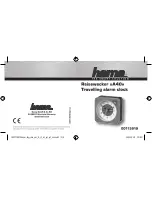
TESTING: Weekly testing is required: This alarm is equipped with two test but-
tons, which will verify the alarm calibration limits. Test button "A" should be
used for the normal weekly testing. Push and hold test button "A" on the cover
for a minimum of 10 seconds. This will sound the alarm if all the electronic cir-
cuitry, horn, and battery are working. If the alarm does not sound, the battery is
fresh and the green LED is on then the alarm must be replaced.
If the green LED is not on, check the fuse or circuit breaker supplying power to
the alarm circuit and verify the alarm is receiving AC power.
Alarm sensitivity verification test: Where required this test must be conducted as
specified in NFPA 72 chapter 10.
• Complete the normal weekly testing procedure as outlined. The alarms will
sound when test button "A" is pushed.
• Push and hold test button "B" for 10 seconds. The red LED will illuminate but
the alarm
MUST NOT SOUND
. If the alarm sounds during this test, it means
the alarms sensitivity has increased, which could result in nuisance alarms.
Increased sensitivity is typically a result of dust build up in the alarm. Follow
the cleaning instructions outlined in section 6 of the manual to clean your
alarm.
• To check for proper smoke entry into the alarm, Kidde recommends using
aerosol smoke manufactured by Home Safeguard Industries. Follow the test-
ing instructions supplied by Home Safeguard Industries. The spray should be
sprayed (towards the alarm) parallel to the wall or ceiling on which the alarm
is mounted. This will insure that the smoke enters the alarm through the
perimeter openings between the alarm base and cover. Excessive use of
aerosol test sprays at close range may permanently alter the alarm sensitivity.
NEVER USE an open flame or combustible materials to test your alarm, you
could damage the alarm or ignite nearby materials and start a structure fire.
TEST THE ALARM WEEKLY TO ENSURE PROPER OPERATION. Erratic or low sound
coming from your alarm may indicate a defective alarm, and it should be
returned for service (see Section 12).
5. NUISANCE ALARMS
Smoke alarms are designed to minimize nuisance alarms. Cigarette smoke will
not normally set off the alarm, unless the smoke is blown directly into the alarm.
Combustion particles from cooking may set off the alarm if the alarm is located
close to the cooking area. Large quantities of combustible particles are generat-
ed from spills or when broiling. Using the fan on a range hood which vents to



































